Dwarf zamioculcas Zenzi - description of the plant
Zamioculcas Zenzi dwarf is an artificially bred variety with shortened petioles. This houseplant is native to tropical Africa. Exotic handsome man possesses brutal power and remarkable endurance. It appeared on sale in the late 90s, but won many fans among flower growers and designers.
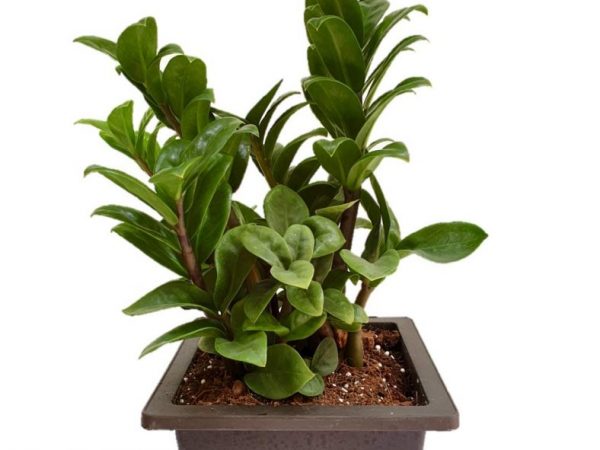
Zamioculcas Zenzi photo
general description
Zamioculcas zamiifolia (Zamioculcas zamiifolia) is a genus of perennial herbaceous plants of the Aroid family. It grows in mountainous rainforests, where periods of rain alternate with drought. Thickets of plants are found both in the shade and in the open sun.
Interesting: Zamioculcas is called "dollar", "currency" or "money tree". Another name for it is "flower of celibacy".
This plant cannot be confused with any other. Thick feathery leaves up to 60-100 cm long emerge from the tuberous stem. On a stalk-shaped petiole (rachis), fleshy, waxy leaves, as if varnished, sit in pairs. Leaves and tubers store water.
The plant does not bloom in the room, and its flowers are nondescript, greenish. It is unpretentious, tolerates rare watering, shading, dry air.
Attention! Zamioculcas juice is poisonous and can irritate the skin.
Form features
The Zenzi variety is very decorative. Features:
- squat leaves (maximum length 60 cm);
- thickened petioles;
- leaves are oval, close-set;
- deep dark green color with bright shine.
The life span of a zamiokulkas is about 10 years.
Purchase and adaptation
Zamioculcas Zenzi is not often found on sale. It can be purchased from online stores or collectors.
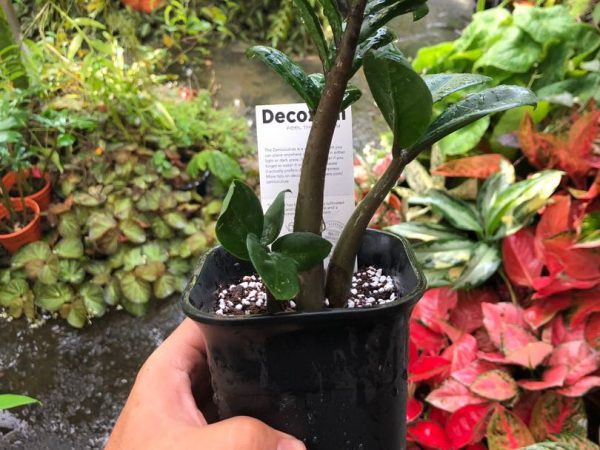
Zamioculcas Zenzi home care
Adaptation to room conditions will take 2-3 weeks. The plant is placed in a well-lit, but not sunny place. Water in moderation. because it does not tolerate excessive dampness and stagnation of moisture in the pot.
Most of the plants are imported in a transport substrate that must be replaced with permanent soil.
Landing rules
- Zamioculcas grows slowly. It is transplanted every two years, and an adult bush is even less common. The pot is taken strong and stable, 2-3 cm larger than the previous one.
- The succulent rhizome does not like damage, so they use the transshipment method without straightening or cutting the roots.
- The plant is provided with good drainage to avoid stagnant water at the roots.
- The correct soil is loose, water and air permeable.
Wear protective gloves during transplant.
The necessary conditions
A tropical guest is easy to care for and can delight the owner with lush foliage for a long time. We list the basic requirements of the flower for the conditions of detention.
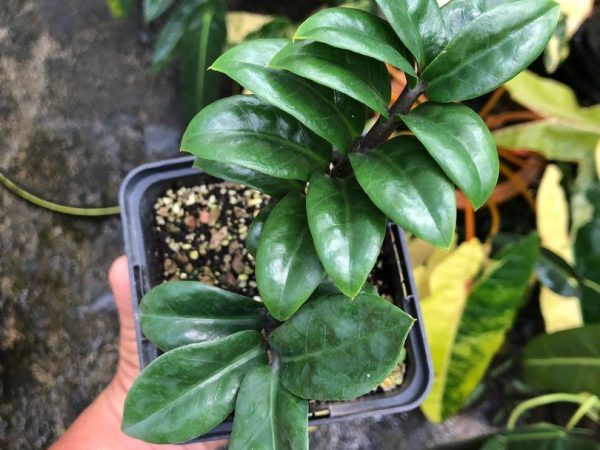
Zamioculcas Zenzi dwarf
Soil selection
In nature, zamioculcas grows on stony, organic-poor soils with a neutral reaction.Suitable for him:
- universal soil with the addition of disintegrants: perlite, expanded clay, coarse sand;
- composition of leaf, sod land, peat and sand in equal proportions;
- soil for cacti;
- coconut chips or bark for orchids with the addition of peat soil;
- Akadama soil.
Before planting, the soil is disinfected by steaming for 10-15 minutes in a water bath, or spilling it with boiling water.
Location
The best place for a currency tree in a room is a sunny window. Zamioculcas tolerates shading, but it is not worth keeping it in a dark corner: the leaves will grow twisted and weakened, the plant will lose its decorative effect.
The scorching sun with rare watering is also undesirable. If it's too hot on the window, shade the plant. Otherwise, it will stop growing and go into a state of forced rest.
The optimum temperature for growing is 20-25 ° C. In extreme heat (around 30 ° C), provide watering and fresh air. And at low temperatures in winter (12-15 ° C), the frequency of watering, on the contrary, needs to be reduced.
Care
Top dressing
Fertilize the plant during the growth period, once every two weeks. It is convenient to feed it with long-playing mineral fertilizers for decorative deciduous plants - sticks and granules, adding them to the soil when planting.
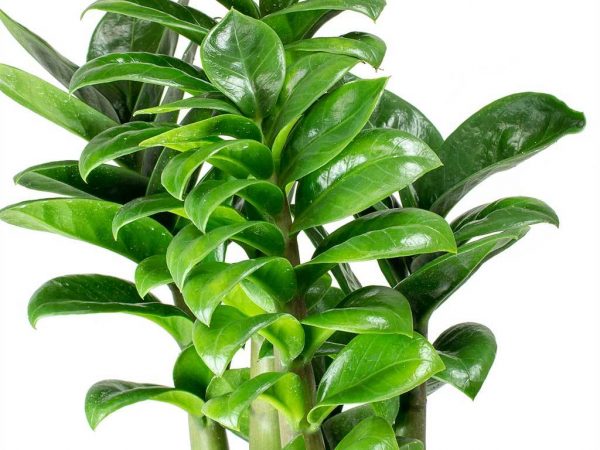
Zamioculcas Zenzi description
Watering
The main danger when watering zamiokulkas is excessive moisture, due to which the roots of the succulent are prone to rotting.
Sometimes it is recommended to water once a month, like cacti. Such extreme forces the plant to "fall asleep", which is why the exotic grows very slowly.
So, the correct watering should be:
- regular;
- warm water;
- with drying the soil in between;
- watering frequency depends on the season and temperature;
- excess water must be drained from the pan.
Sometimes it is useful to spray it to remove dust from the leaves.
Transfer
If the pot is too small for the plant, the least traumatic handling is done. Step-by-step instruction:
- Pour a layer of expanded clay drainage into a new pot with a thickness of at least 3 cm.
- Sprinkle with soil.
- We take out the plant from the old pot and set it on the ground.
- Pour fresh soil around the root ball and carefully compact it. The top of the tuber should not be buried; it is better to leave it just above the soil level.
If manipulations with the rhizome are coming - dividing or cutting off rotten parts - all wound surfaces must be dried for at least two hours and sprinkled with an antiseptic (crushed coal).
Reproduction methods
It is not so easy to propagate Zenzi Zamioculcas at home, but the game is worth it. We will tell you which breeding methods are suitable.
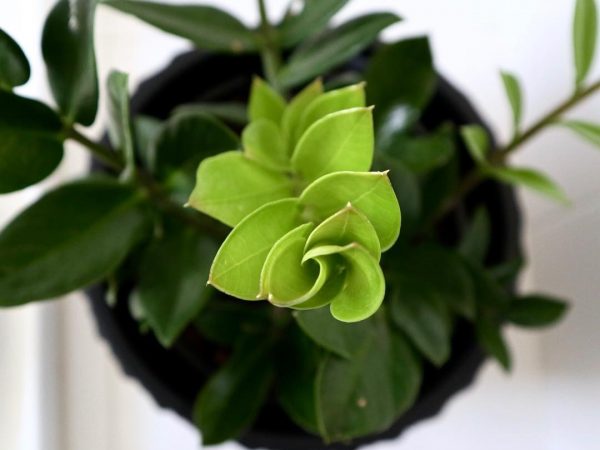
Zamioculcas Zenzi care
Seeds
Finding Zamioculcas seeds is extremely rare. If you get them, you are more likely to grow not Zenzi, but a species form.
The seeds are placed in a loose moist substrate for violets or cacti at a distance of 2-3 cm between them, covered with glass or film. Spray from time to time. After the appearance of two true leaves, the seedlings can be planted.
Cuttings
A stump is a whole leaf. To propagate a plant, proceed as follows:
- Cut off the sheet, delete the bottom 4-5 segments.
- Dry the cutting in the shade.
- Sprinkle the cut with charcoal powder.
- We plant it in a pot of soil and put it in a room greenhouse. Option: put the lower end in a jar of water or a wet hydrogel. We keep the water clean.
- After the roots and nodules appear, we plant them in a pot and cover with a plastic bottle.
- When new leaves germinate, the shelter can be removed.
Important: zamioculcas from a store are not suitable for breeding, as they are treated with chemicals. Cuttings are taken from healthy adult plants adapted to the home.
By dividing an adult plant
It is more convenient to propagate zamioculcas by dividing the tuber in the spring, when transplanting into a new pot. This method allows you to get several large plants.
Stages:
- We take out the plant from the pot.
- We break the tuber with our hands into pieces with one or two buds (Important: You cannot cut the tubers!)
- We dry the fracture sites for a couple of hours and disinfect it with charcoal.
- We plant in prepared pots with moist soil.
- Do not water during the first week.
Leaf blades
Reproduction by leaves will take several months, but it is less traumatic for a valuable variety. The sequence of actions is approximately the same as for grafting:
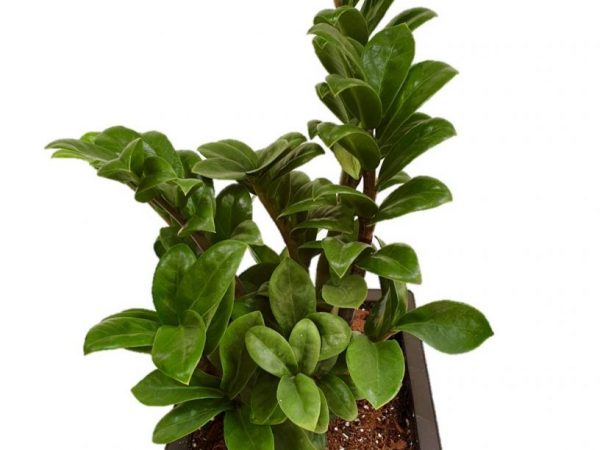
Dwarf zamioculcas
- the leaves are cut off and dried a little;
- disinfected with crushed coal;
- planted obliquely into the soil by a third of the length;
- cover with foil.
Be patient and do not throw away the leaves if they wither: young nodules may already have formed in the soil.
Diseases and pests
Signs of zamioculcas diseases, their causes and methods of prevention are discussed in the table.
| Sign | The cause of the disease | Prevention and treatment |
| Dark spots on the leaves | Excessive watering or draft | Reduce watering, clean root rot. Change location. |
| Leaf plates turn yellow | Overdrying or flooding with cold water | Adjust watering. Transplant with removal of diseased roots. |
| Sticky discharge on leaves, dark bumps, dots | Damage by pests (scale insects and others) | Washing leaves, spraying with insecticides. |
With good care, Zamioculcas will delight you with excellent health!

